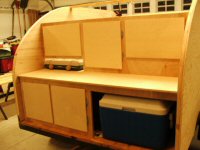To deal with the real vs. the theoretical in this question, use a Voltmeter to measure voltage drop at the Trailer Plug while the Subaru is running. In the Trailer, turn on ~4 Amps 'worth' of load to simulate Fridge load. Your Voltmeter will tell you if the Fridge is likely to hit the low voltage cutout setpoint. Fridge current draw is periodic, and highest when full of warm Pop, etc.. Plug it in at the Trailer or another Receptacle to measure 'reality'. A
periodic 4 Amps draw may be just fine.
The Trailer Battery will draw the most charging current, obviously, after it's been used. When first driving away after use, keep the Audio System volume moderate to keep current draw moderate IF that's even an issue. The pounding Rap music may have to wait until the Trailer Battery charges some! ;-0
Some folks like Fuses; I use RV-style Circuit Breakers because they reset after transient issues. I can disconnect them and find any shorts/problems with an Ohmmeter, if req'd. Convenience [in not replacing Fuses] is king in the boonies, as it is in Home Breaker Panels vs. Fuses of old... Fuses are cheaper, however.
My hunch: adding a rear Cig Lighter Receptacle to the existing #10 wire likely will work. Add a 30 Amp CB/Fuse at the Battery if you like. Another limiting factor is the max available output of the Subaru Alternator before wiring losses, since we're not talking the HD Alternator on a Dodge Diesel here! ;-) Subaru is likely acknowledging that their system can handle upgraded Audio OR auxiliary Cig Lighter current draw - but not both - given Factory tendency to undersize wiring. Charging an 'additional' Trailer Battery is
possibly taxing the system already. No point in running more wiring of
any size if other factors limit available current. The Subaru Op Manual will tell you the Fuse rating - and max acceptable current draw - when an Aux +12 VDC Cig receptacle is installed vs. upgraded Audio.
See 'Handy Bob's' opinions, including wire sizing, here. RVers with Solar Systems swear by his sometimes-over-the-top advice:
http://handybobsolar.wordpress.com/2009/07/22/solar-power-that-works/
My point above was that IF you wanted to upsize wire, parallel runs is one old trick to do so. My opinion, kept to myself, was that your existing #10 wire run would be sufficient since there's likely other limitations already. Here's a Wire Chart w/fine print qualifiers:
http://www.powerstream.com/Wire_Size.htm (which mine does). So much for that idea
(which mine does). So much for that idea 





